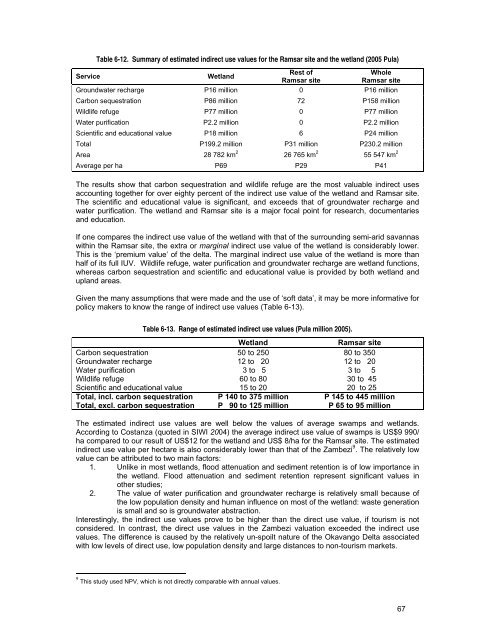Download PDF - Anchor Environmental
Download PDF - Anchor Environmental
Download PDF - Anchor Environmental
Create successful ePaper yourself
Turn your PDF publications into a flip-book with our unique Google optimized e-Paper software.
Service<br />
Table 6-12. Summary of estimated indirect use values for the Ramsar site and the wetland (2005 Pula)<br />
Wetland<br />
Rest of<br />
Ramsar site<br />
Whole<br />
Ramsar site<br />
Groundwater recharge P16 million 0 P16 million<br />
Carbon sequestration P86 million 72 P158 million<br />
Wildlife refuge P77 million 0 P77 million<br />
Water purification P2.2 million 0 P2.2 million<br />
Scientific and educational value P18 million 6 P24 million<br />
Total P199.2 million P31 million P230.2 million<br />
Area 28 782 km 2 26 765 km 2 55 547 km 2<br />
Average per ha P69 P29 P41<br />
The results show that carbon sequestration and wildlife refuge are the most valuable indirect uses<br />
accounting together for over eighty percent of the indirect use value of the wetland and Ramsar site.<br />
The scientific and educational value is significant, and exceeds that of groundwater recharge and<br />
water purification. The wetland and Ramsar site is a major focal point for research, documentaries<br />
and education.<br />
If one compares the indirect use value of the wetland with that of the surrounding semi-arid savannas<br />
within the Ramsar site, the extra or marginal indirect use value of the wetland is considerably lower.<br />
This is the ‘premium value’ of the delta. The marginal indirect use value of the wetland is more than<br />
half of its full IUV. Wildlife refuge, water purification and groundwater recharge are wetland functions,<br />
whereas carbon sequestration and scientific and educational value is provided by both wetland and<br />
upland areas.<br />
Given the many assumptions that were made and the use of ‘soft data’, it may be more informative for<br />
policy makers to know the range of indirect use values (Table 6-13).<br />
Table 6-13. Range of estimated indirect use values (Pula million 2005).<br />
Wetland<br />
Ramsar site<br />
Carbon sequestration 50 to 250 80 to 350<br />
Groundwater recharge 12 to 20 12 to 20<br />
Water purification 3 to 5 3 to 5<br />
Wildlife refuge 60 to 80 30 to 45<br />
Scientific and educational value 15 to 20 20 to 25<br />
Total, incl. carbon sequestration P 140 to 375 million P 145 to 445 million<br />
Total, excl. carbon sequestration P 90 to 125 million P 65 to 95 million<br />
The estimated indirect use values are well below the values of average swamps and wetlands.<br />
According to Costanza (quoted in SIWI 2004) the average indirect use value of swamps is US$9 990/<br />
ha compared to our result of US$12 for the wetland and US$ 8/ha for the Ramsar site. The estimated<br />
indirect use value per hectare is also considerably lower than that of the Zambezi 9 . The relatively low<br />
value can be attributed to two main factors:<br />
1. Unlike in most wetlands, flood attenuation and sediment retention is of low importance in<br />
the wetland. Flood attenuation and sediment retention represent significant values in<br />
other studies;<br />
2. The value of water purification and groundwater recharge is relatively small because of<br />
the low population density and human influence on most of the wetland: waste generation<br />
is small and so is groundwater abstraction.<br />
Interestingly, the indirect use values prove to be higher than the direct use value, if tourism is not<br />
considered. In contrast, the direct use values in the Zambezi valuation exceeded the indirect use<br />
values. The difference is caused by the relatively un-spoilt nature of the Okavango Delta associated<br />
with low levels of direct use, low population density and large distances to non-tourism markets.<br />
9 This study used NPV, which is not directly comparable with annual values.<br />
67
















